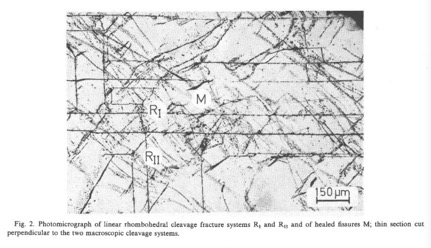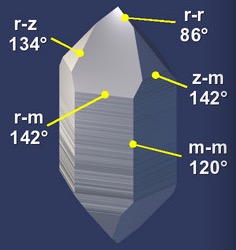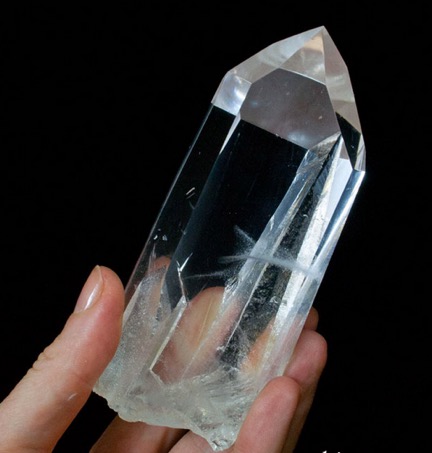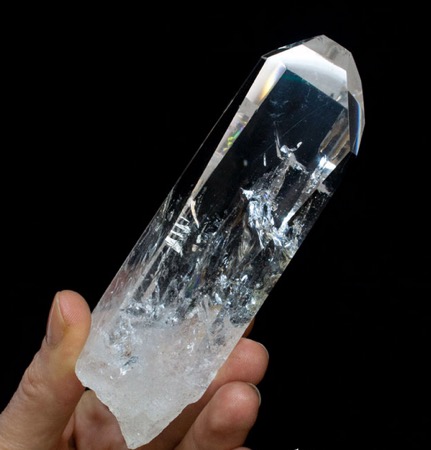While at the Flagstaff Gem, Mineral & Jewelry show this past August, my fellow Coconino Lapidary Club member and collector friend, Gordon, and I spotted an unusual appearing polished quartz crystal. Upon closer inspection we spotted a geometrical array of fine lines within the crystal which looked to be perpendicular to each other. The appearance of the fine lines seemed similar to the line of incomplete cleavage shown in the octahedral diamond crystal. Mindat, [Ref 1], cites quartz as exhibiting cleavage, as well as fracture, (surprising to me upon discovery, as most sources I’ve seen describe quartz as only exhibiting fracturing), I suggested that the fine lines might be due to cleavage. Gordon purchased this crystal, (shown in Figure 1), with the intention of our investigating it to ascertain if the lines were indeed due to cleavage.
The result of our efforts was a yes. The sharp lines we observed were caused by cleavage along rhombohedral planes, as indicated by our measured and calculated angle of 87.5 degrees between the lines, agreeing well with the literature value of 86 degrees. How we got here is described below, along with how to go about finding demonstrations of cleavage in quartz along other crystallographic planes and how to obtain values for the compressive strength of quartz from the literature.
Description of Cleavage in Quartz
In its description of quartz, Mindat states that quartz fractures exhibiting a conchoidal, (shell-like), surface [Ref 1] and, with respect to cleavage in quartz, that when “The rhombohedral cleavage {10-11} is most often seen, there are at least six others reported.”. This summary led to a web-search resulting in papers which described cleavage occurring in quartz due to shearing along lattice planes, which is due to stresses induced by very high static pressure [Ref 2].
A Cleavage Pattern Under Static Pressure
Fragments of large, single crystals of quartz, which had been embedded in veins located in the basement rocks in Madagascar during the age of the supercontinent, Gondwana, [Ref 3], were used in the study we examined. Separation of India from Madagascar incurred intense pressures and shearing of the basement rocks. Micrographs of thin sections, prepared from the fragments, disclosed two sets of parallel cleavage lines running essentially perpendicularly to each other, as shown in Figure 2 (Figure 2 of Ref 2). Orientation of the thin section by x-Ray diffraction [Ref 4] allowed assignment of cleavage, in both sets of parallel lines, to be directed along rhombohedral planes.
Are the Essentially Perpendicular Lines in the Crystal of Figure 1 Due to Cleavage?
Comparison of the array of essentially perpendicular cleavage lines, with the two prominent essentially perpendicular lines on the left side of the quartz crystal, in Figure 1, suggested that these lines and others in the crystal might represent cleavage planes. In order to examine this possibility, the angle between the pair of approximately perpendicular lines on the left side of the crystal, were used to obtain a value for the angle between the nearly perpendicular sides. An estimate for the angle was obtained by measuring the lengths of the sides of the resulting right triangle, constructed by erecting a perpendicular to one side and computing the tangent of the included acute angle. This value allowed computation of the arctangent of the angle, giving the computed value of 87.5 degrees, which agrees well with the value of 86 degrees between the rhombohedral (r-r) faces of the drawn crystal shown in Figure 3, (Figure 3 of Reference 5), [Ref 5]
Cleavage in Quartz Along Other Crystallographic Planes
Having obtained this result, we next researched the web further, looking for quartz crystals which exhibited evidence of cleavage along other possible planes, as given in Table 1 of Reference 5, as shown in Figure 4. Our search, of some duration, resulted in finding the two quartz crystals shown in Figures 5 and 6.
Examination of the crystal in Figure 5 disclosed two suspected cleavage lines in its lower left region. The lines intersect each other, with one being parallel to the axis of the axis parallel to the unit, or secondary prism, of the crystal and the other line intersecting it at an obtuse angle. Calculation of this angle, from measurements on an enlargement of the photo of the crystal, gave a value of 140.6 degrees which agrees closely with the angle between the unit prism and second order trigonal pyramid, (Table, Figure 5), which is shown in Figure 3 as the angle z-m = 142 degrees. In appearance both lines lack the sharpness of those of rhombohedral cleavage. This is probably due to the camera angle in the photo not being perfectly perpendicular to the cleavage lines.
Examination of Figure 6 disclosed four suspected cleavage lines perpendicular to the axis of the prism and one angled at an angle seen in the rhombohedral cleavage in Figure 1. These lines are due to cleavage along the planes parallel to the basal pinacoid (face) of the crystal (Table, Figure 5).These cleavage lines also lack the sharpness of the rhombohedral cleavage lines in Figure 1, probably due to the camera angle. [Ref 6]
Reported Values of the Compressive Strengths of Quartz and Other Silicate Minerals
We found the following references on the web. All gave results obtained at room temperature ~ 72 degrees F. In two experiments, using uniaxial quasi-static (slowly applied force)directed perpendicularly to the prism face, gave values of 2.55 Gigapascals (369,847 psi) [Ref 7] and 2.74 Gigapascals (981,719 psi) [Ref 8], respectively. In two experiments performed to determine the elastic properties of quartz results were obtained with hydrostatic pressures up to 10 GPa ( 1,740,456 psi) and 12GPa (2,088,547 psi), respectively. [Ref 9]









